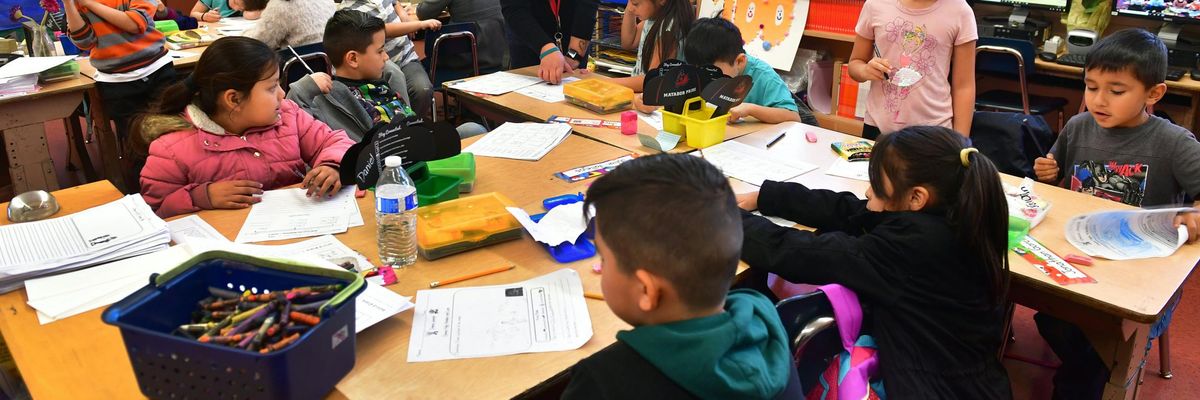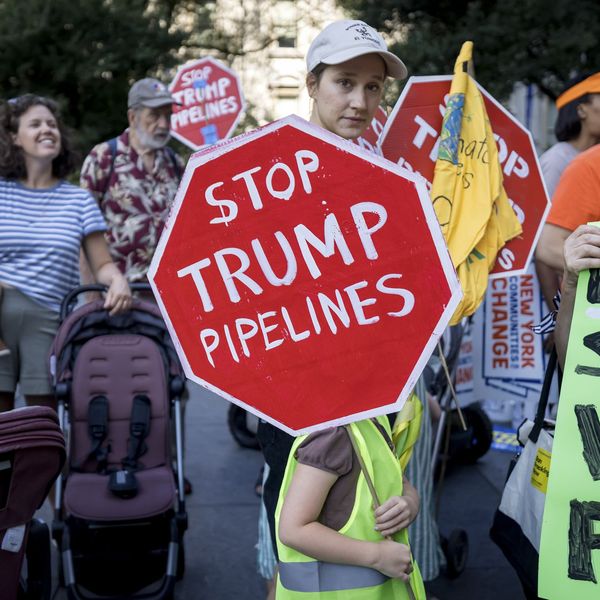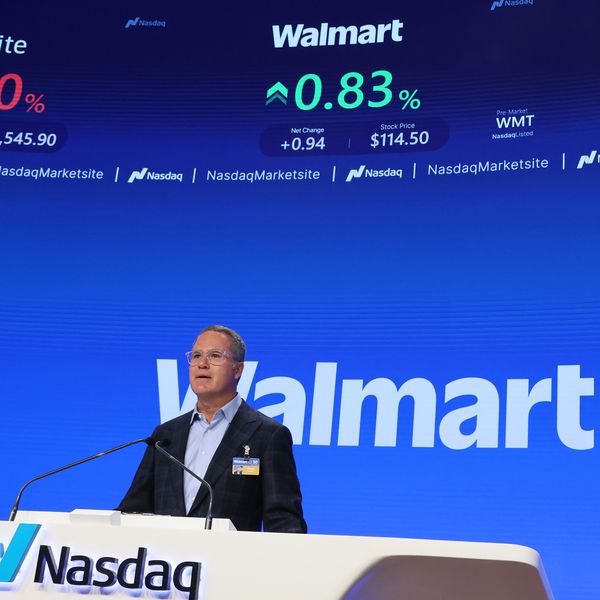
A teacher instructs first-graders at Telfair Elementary School in Pacoima, California on February 8, 2019. (Photo: Frederic J. Brown/AFP via Getty Images)
Markey, Levin, and Bowman Unveil Bill to 'Get Toxic Substances Out of Schools'
"We live in the richest country in the world. Every single kid should have a safe and healthy learning environment that facilitates their growth and unlocks their brilliance."
Citing the high prevalence of toxic contaminants in U.S. schools--especially in low-income districts--a trio of congressional Democrats on Thursday introduced a bill that would authorize over $52 billion in funding over the next decade to remove dangerous substances from education buildings nationwide.
"We need a revolution in how we invest in and prioritize our school infrastructure, and that starts with getting toxins out of schools."
--Rep. Jamaal Bowman
The Get Toxic Substances Out of Schools Act of 2021 (pdf)--introduced by Sen. Ed Markey (D-Mass.) and Rep. Andy Levin (D-Mich.) and Rep. Jamaal Bowman (D-N.Y.)--would amend the Toxic Substances Control Act (TSCA) to authorize grants for the remediation of contaminants in schools, where approximately 53 million children and six million adults spend a significant portion of their days, according to (pdf) the U.S. Environmental Protection Agency (EPA).
The agency says approximately half of these students and staff "may be exposed to polluted indoor air, lead, asbestos, chemical fumes, pesticides, molds, and other toxins" in more than 120,000 public and private school buildings. Other contaminants mentioned in the new bill include ' forever chemicals': polychlorinated biphenyls (PCBs) and per- and polyfluoroalkyl substances (PFAS).
"Many of these buildings are old, in poor condition, and may contain environmental conditions that pose increased risks to the health of children and staff," the EPA notes. "Reducing exposures to environmental hazards in schools can help children's health. Healthier school environments enable children to learn and produce more in the classroom which can improve their performance and achievements later in life."
In a statement, Markey--who is chair of the Senate Subcommittee on Clean Air, Climate, and Nuclear Safety--said that "there is no excuse for the presence of toxic substances at schools, and it is long past time we provided the resources to clean them up. Children need clean air to breathe, safe water to drink, and a healthy environment to learn. They need schools free of environmental hazards, and a real chance to thrive."
"By taking action and investing in clean schools, we can create jobs and healthier communities all at the same time," he added.
"Toxic chemicals like PFAS have no place in our schools, yet in Michigan and around the country students are being exposed to toxic substances every day."
--Rep. Andy Levin
Levin said that "every child in this country deserves to attend a school where they can learn and grow in a healthy, safe environment. Toxic chemicals like PFAS have no place in our schools, yet in Michigan and around the country students are being exposed to toxic substances every day."
"The Get Toxic Substances Out of Schools Act is the long-overdue solution to this problem," Levin asserted. "It provides the funding states need to clean up our schools and instructs the EPA to work closely with states to ensure they have access to the latest data and research on the toxins that are harming our children."
Bowman--a former public middle school teacher and principal, and lead sponsor of the Green New Deal for Public Schools Act--said that "we live in the richest country in the world. Every single kid should have a safe and healthy learning environment that facilitates their growth and unlocks their brilliance."
"It makes absolutely no sense that kids today are expected to try to learn in schools that still contain a number of toxic substances, where just drinking from a water fountain in the hall could make them sick," Bowman added. "We need a revolution in how we invest in and prioritize our school infrastructure, and that starts with getting toxins out of schools."
The new bill is endorsed by organizations including the American Federation of Teachers (AFT), BlueGreen Alliance, Environmental Working Group, Healthy Schools Network, International Union of Painters and Allied Trades, and UndauntedK12.
\u201c.@SenMarkey\u2019s \u201cGet Toxic Substances Out of Schools Act\u201d will not only protect our students from dangerous substances like #PCBs, #PFAS, #lead, and #asbestos, it will create good jobs in communities across the nation. https://t.co/05kUlDSbxn\u201d— BlueGreen Alliance (@BlueGreen Alliance) 1628199000
"Every public school building in American should be a safe and welcoming space. But even before the added threat of Covid-19, far too many students, educators, and school staff were in buildings with poor ventilation, mold, and contaminants like lead and asbestos--especially in high-poverty neighborhoods," said AFT president Randi Weingarten.
"Kids can't learn in that environment, and teachers can't teach," Weingarten continued. "But the Get Toxic Substances Out of Schools Act would create dedicated federal resources to help make every public school a place where parents feel confident in their children's well-being, educators, and support staff feel safe enough to do their jobs, and students can focus on learning and growth."
An Urgent Message From Our Co-Founder
Dear Common Dreams reader, The U.S. is on a fast track to authoritarianism like nothing I've ever seen. Meanwhile, corporate news outlets are utterly capitulating to Trump, twisting their coverage to avoid drawing his ire while lining up to stuff cash in his pockets. That's why I believe that Common Dreams is doing the best and most consequential reporting that we've ever done. Our small but mighty team is a progressive reporting powerhouse, covering the news every day that the corporate media never will. Our mission has always been simple: To inform. To inspire. And to ignite change for the common good. Now here's the key piece that I want all our readers to understand: None of this would be possible without your financial support. That's not just some fundraising cliche. It's the absolute and literal truth. We don't accept corporate advertising and never will. We don't have a paywall because we don't think people should be blocked from critical news based on their ability to pay. Everything we do is funded by the donations of readers like you. Will you donate now to help power the nonprofit, independent reporting of Common Dreams? Thank you for being a vital member of our community. Together, we can keep independent journalism alive when it’s needed most. - Craig Brown, Co-founder |
Citing the high prevalence of toxic contaminants in U.S. schools--especially in low-income districts--a trio of congressional Democrats on Thursday introduced a bill that would authorize over $52 billion in funding over the next decade to remove dangerous substances from education buildings nationwide.
"We need a revolution in how we invest in and prioritize our school infrastructure, and that starts with getting toxins out of schools."
--Rep. Jamaal Bowman
The Get Toxic Substances Out of Schools Act of 2021 (pdf)--introduced by Sen. Ed Markey (D-Mass.) and Rep. Andy Levin (D-Mich.) and Rep. Jamaal Bowman (D-N.Y.)--would amend the Toxic Substances Control Act (TSCA) to authorize grants for the remediation of contaminants in schools, where approximately 53 million children and six million adults spend a significant portion of their days, according to (pdf) the U.S. Environmental Protection Agency (EPA).
The agency says approximately half of these students and staff "may be exposed to polluted indoor air, lead, asbestos, chemical fumes, pesticides, molds, and other toxins" in more than 120,000 public and private school buildings. Other contaminants mentioned in the new bill include ' forever chemicals': polychlorinated biphenyls (PCBs) and per- and polyfluoroalkyl substances (PFAS).
"Many of these buildings are old, in poor condition, and may contain environmental conditions that pose increased risks to the health of children and staff," the EPA notes. "Reducing exposures to environmental hazards in schools can help children's health. Healthier school environments enable children to learn and produce more in the classroom which can improve their performance and achievements later in life."
In a statement, Markey--who is chair of the Senate Subcommittee on Clean Air, Climate, and Nuclear Safety--said that "there is no excuse for the presence of toxic substances at schools, and it is long past time we provided the resources to clean them up. Children need clean air to breathe, safe water to drink, and a healthy environment to learn. They need schools free of environmental hazards, and a real chance to thrive."
"By taking action and investing in clean schools, we can create jobs and healthier communities all at the same time," he added.
"Toxic chemicals like PFAS have no place in our schools, yet in Michigan and around the country students are being exposed to toxic substances every day."
--Rep. Andy Levin
Levin said that "every child in this country deserves to attend a school where they can learn and grow in a healthy, safe environment. Toxic chemicals like PFAS have no place in our schools, yet in Michigan and around the country students are being exposed to toxic substances every day."
"The Get Toxic Substances Out of Schools Act is the long-overdue solution to this problem," Levin asserted. "It provides the funding states need to clean up our schools and instructs the EPA to work closely with states to ensure they have access to the latest data and research on the toxins that are harming our children."
Bowman--a former public middle school teacher and principal, and lead sponsor of the Green New Deal for Public Schools Act--said that "we live in the richest country in the world. Every single kid should have a safe and healthy learning environment that facilitates their growth and unlocks their brilliance."
"It makes absolutely no sense that kids today are expected to try to learn in schools that still contain a number of toxic substances, where just drinking from a water fountain in the hall could make them sick," Bowman added. "We need a revolution in how we invest in and prioritize our school infrastructure, and that starts with getting toxins out of schools."
The new bill is endorsed by organizations including the American Federation of Teachers (AFT), BlueGreen Alliance, Environmental Working Group, Healthy Schools Network, International Union of Painters and Allied Trades, and UndauntedK12.
\u201c.@SenMarkey\u2019s \u201cGet Toxic Substances Out of Schools Act\u201d will not only protect our students from dangerous substances like #PCBs, #PFAS, #lead, and #asbestos, it will create good jobs in communities across the nation. https://t.co/05kUlDSbxn\u201d— BlueGreen Alliance (@BlueGreen Alliance) 1628199000
"Every public school building in American should be a safe and welcoming space. But even before the added threat of Covid-19, far too many students, educators, and school staff were in buildings with poor ventilation, mold, and contaminants like lead and asbestos--especially in high-poverty neighborhoods," said AFT president Randi Weingarten.
"Kids can't learn in that environment, and teachers can't teach," Weingarten continued. "But the Get Toxic Substances Out of Schools Act would create dedicated federal resources to help make every public school a place where parents feel confident in their children's well-being, educators, and support staff feel safe enough to do their jobs, and students can focus on learning and growth."
Citing the high prevalence of toxic contaminants in U.S. schools--especially in low-income districts--a trio of congressional Democrats on Thursday introduced a bill that would authorize over $52 billion in funding over the next decade to remove dangerous substances from education buildings nationwide.
"We need a revolution in how we invest in and prioritize our school infrastructure, and that starts with getting toxins out of schools."
--Rep. Jamaal Bowman
The Get Toxic Substances Out of Schools Act of 2021 (pdf)--introduced by Sen. Ed Markey (D-Mass.) and Rep. Andy Levin (D-Mich.) and Rep. Jamaal Bowman (D-N.Y.)--would amend the Toxic Substances Control Act (TSCA) to authorize grants for the remediation of contaminants in schools, where approximately 53 million children and six million adults spend a significant portion of their days, according to (pdf) the U.S. Environmental Protection Agency (EPA).
The agency says approximately half of these students and staff "may be exposed to polluted indoor air, lead, asbestos, chemical fumes, pesticides, molds, and other toxins" in more than 120,000 public and private school buildings. Other contaminants mentioned in the new bill include ' forever chemicals': polychlorinated biphenyls (PCBs) and per- and polyfluoroalkyl substances (PFAS).
"Many of these buildings are old, in poor condition, and may contain environmental conditions that pose increased risks to the health of children and staff," the EPA notes. "Reducing exposures to environmental hazards in schools can help children's health. Healthier school environments enable children to learn and produce more in the classroom which can improve their performance and achievements later in life."
In a statement, Markey--who is chair of the Senate Subcommittee on Clean Air, Climate, and Nuclear Safety--said that "there is no excuse for the presence of toxic substances at schools, and it is long past time we provided the resources to clean them up. Children need clean air to breathe, safe water to drink, and a healthy environment to learn. They need schools free of environmental hazards, and a real chance to thrive."
"By taking action and investing in clean schools, we can create jobs and healthier communities all at the same time," he added.
"Toxic chemicals like PFAS have no place in our schools, yet in Michigan and around the country students are being exposed to toxic substances every day."
--Rep. Andy Levin
Levin said that "every child in this country deserves to attend a school where they can learn and grow in a healthy, safe environment. Toxic chemicals like PFAS have no place in our schools, yet in Michigan and around the country students are being exposed to toxic substances every day."
"The Get Toxic Substances Out of Schools Act is the long-overdue solution to this problem," Levin asserted. "It provides the funding states need to clean up our schools and instructs the EPA to work closely with states to ensure they have access to the latest data and research on the toxins that are harming our children."
Bowman--a former public middle school teacher and principal, and lead sponsor of the Green New Deal for Public Schools Act--said that "we live in the richest country in the world. Every single kid should have a safe and healthy learning environment that facilitates their growth and unlocks their brilliance."
"It makes absolutely no sense that kids today are expected to try to learn in schools that still contain a number of toxic substances, where just drinking from a water fountain in the hall could make them sick," Bowman added. "We need a revolution in how we invest in and prioritize our school infrastructure, and that starts with getting toxins out of schools."
The new bill is endorsed by organizations including the American Federation of Teachers (AFT), BlueGreen Alliance, Environmental Working Group, Healthy Schools Network, International Union of Painters and Allied Trades, and UndauntedK12.
\u201c.@SenMarkey\u2019s \u201cGet Toxic Substances Out of Schools Act\u201d will not only protect our students from dangerous substances like #PCBs, #PFAS, #lead, and #asbestos, it will create good jobs in communities across the nation. https://t.co/05kUlDSbxn\u201d— BlueGreen Alliance (@BlueGreen Alliance) 1628199000
"Every public school building in American should be a safe and welcoming space. But even before the added threat of Covid-19, far too many students, educators, and school staff were in buildings with poor ventilation, mold, and contaminants like lead and asbestos--especially in high-poverty neighborhoods," said AFT president Randi Weingarten.
"Kids can't learn in that environment, and teachers can't teach," Weingarten continued. "But the Get Toxic Substances Out of Schools Act would create dedicated federal resources to help make every public school a place where parents feel confident in their children's well-being, educators, and support staff feel safe enough to do their jobs, and students can focus on learning and growth."

